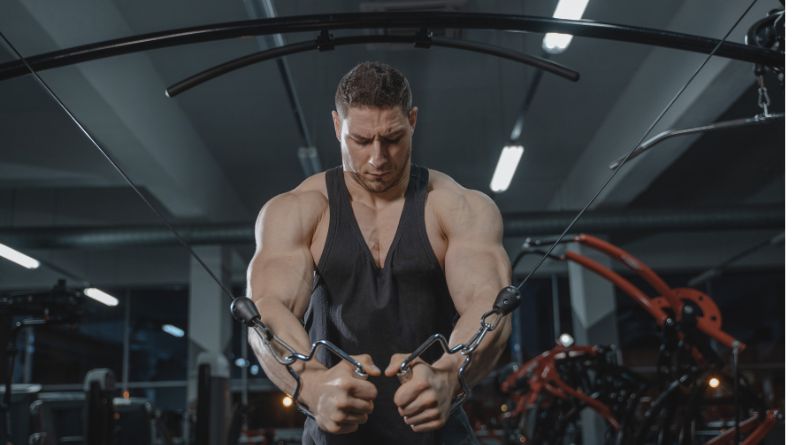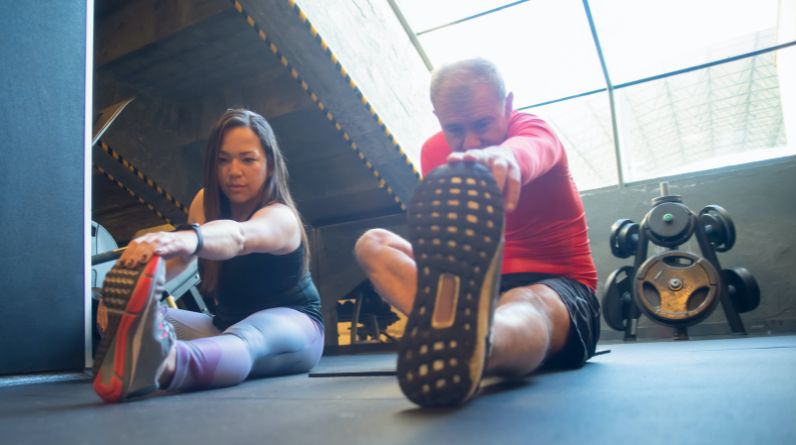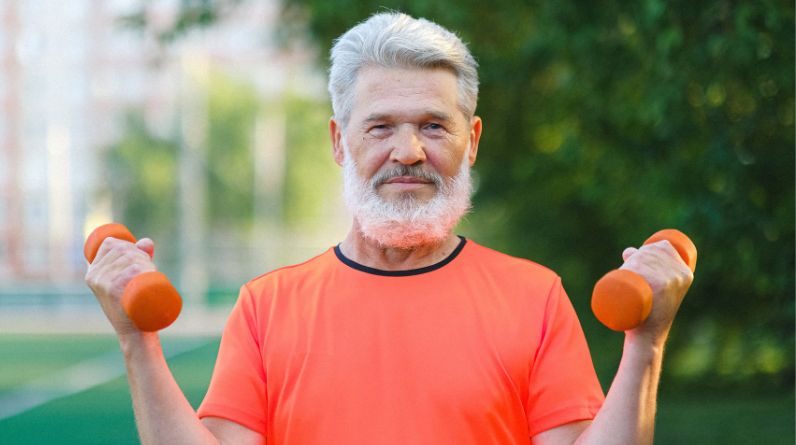
BUILDING STRENGTH AND FITNESS IN YOUR LIVING SPACE
In the world of fitness, compound exercises reign supreme as powerful tools for building strength, muscle, and overall fitness. While many envision well-equipped gyms as the only domain for these exercises, the truth is that you can achieve remarkable results right in the comfort of your own home. Compound exercises at home offer a convenient and efficient way to work multiple muscle groups, elevate heart rate, and achieve a well-rounded physique. In this article, we delve into the realm of compound exercises, exploring their benefits, providing a comprehensive guide to performing them at home, and addressing common questions to help you embark on a transformative fitness journey.
The Power of Compound Exercises: A Holistic Approach to Fitness
Compound exercises, also known as multi-joint exercises, involve the movement of multiple joints and engage several muscle groups simultaneously. These exercises contrast with isolation exercises that target only a single muscle group. The efficiency and effectiveness of compound exercises lie in their ability to mimic real-life movements, making them essential for functional strength and overall fitness.
Benefits of Compound Exercises
Compound exercises stand as a cornerstone of effective and efficient workouts, offering a multitude of benefits that extend beyond just physical gains. These exercises, which involve the coordinated movement of multiple joints and muscle groups, form an integral part of any well-rounded fitness routine. Let’s dive deeper into the advantages that compound exercises bring to the table:
1. Time Efficiency: Making Every Second Count
In the fast-paced modern world, time is a precious commodity, and compound exercises offer a solution that maximizes the effectiveness of your workouts. By engaging multiple muscle groups simultaneously, you’re able to achieve more in less time. In a single movement, you’re targeting a wide range of muscles, making each repetition count towards a more comprehensive and efficient workout session. This attribute is particularly advantageous when working out at home, where you may have limited time and space to dedicate to your fitness routine.
2. Muscle Engagement: The Power of Synergy
When you perform a compound exercise, you’re orchestrating a symphony of muscle groups working together in harmony. This heightened level of engagement leads to increased muscle recruitment, setting the stage for accelerated muscle development and strength gains. The dynamic interplay between various muscles not only stimulates their growth but also enhances overall muscle coordination and balance. This comprehensive approach ensures that no muscle group is left behind, contributing to a balanced and well-proportioned physique.
3. Calorie Burn: Igniting the Furnace of Fat Loss
Compound exercises serve as a furnace for burning calories and torching fat. The intricate nature of these movements elevates your heart rate, sending your body into an efficient fat-burning mode. The elevated metabolic demand persists even after your workout, as your body works to repair and recover from the intense effort. This makes compound exercises an excellent choice for those seeking weight management and fat loss. When combined with proper nutrition, these exercises create a potent formula for shedding excess pounds and revealing lean muscle beneath.
4. Functional Strength: Preparing for the Real World
Life is a series of movements, from lifting groceries to playing with your children. Compound exercises replicate these natural movements, enhancing your functional strength and ability to navigate daily tasks with ease. By training your body to work harmoniously through multi-joint actions, you’re building a foundation that directly translates to improved performance in everyday activities. Whether you’re lifting, twisting, or reaching, the strength gained from compound exercises ensures that you’re prepared for whatever life throws your way.
5. Hormonal Response: Unleashing Growth and Vitality
Compound exercises have a profound impact on your body’s hormonal response, unleashing a cascade of growth-promoting hormones. The intensity and complexity of these exercises stimulate the release of testosterone and growth hormone, both of which are essential for muscle growth and overall fitness improvements. This hormonal surge not only facilitates muscle development but also contributes to enhanced bone density, metabolism, and overall vitality. By incorporating compound exercises into your routine, you’re tapping into your body’s natural potential for growth and rejuvenation.
Creating Your Home Workout Space
In the realm of home workouts, your environment plays a pivotal role in shaping your success. Just as a canvas serves as the foundation for a masterpiece, your workout space sets the stage for your fitness journey. Designing a well-organized and inviting workout area can significantly impact your motivation, consistency, and overall workout effectiveness. Here’s a deeper look at how to curate a home workout space that inspires and empowers you:
1. Find Your Fitness Nook
Begin by identifying a dedicated space in your home that can serve as your workout sanctuary. Choose an area with enough room to move freely and perform exercises without hindrance. Whether it’s a spare room, a corner of your living room, or even your backyard, make sure the space is free from clutter and distractions. This designated spot will become your haven for physical transformation, where you can focus solely on your workout goals.
2. Clear the Path
Imagine a blank canvas waiting for the first stroke of color. Similarly, your workout space should be a clean canvas ready to be adorned with your movements. Clear away any obstacles, furniture, or items that might impede your range of motion. A clutter-free environment not only promotes safety but also allows you to execute exercises with precision and confidence.
3. Equip for Success
Just as an artist selects the finest brushes and paints, you need the right tools to craft your fitness masterpiece. Invest in a few essential pieces of workout equipment that align with your goals and preferences. Resistance bands, dumbbells, stability balls, and a yoga mat are versatile additions that can amplify your home workout routine. These items provide variety and resistance to your exercises, ensuring that you can engage different muscle groups and progress over time.
4. Let There Be Light
Natural light has a transformative effect, creating an atmosphere of energy and positivity. If possible, position your workout space near a window or in a well-lit area. Natural light not only enhances your mood but also enables you to perform movements with better form and visibility. If natural light isn’t abundant, consider adding sufficient artificial lighting to ensure that your workout space is well-illuminated.
5. Personalize and Inspire
Just as an artist surrounds themselves with inspiration, infuse your workout space with elements that motivate and energize you. Hang motivational quotes, place plants or artwork, or even play uplifting music to create an environment that sparks your enthusiasm. Your workout space should reflect your personality and aspirations, making it a place you look forward to visiting each day.
6. Maintain Order and Accessibility
Organization is the cornerstone of an effective workout space. Arrange your equipment in an orderly manner, ensuring that everything is easily accessible. This not only streamlines your workouts but also reduces the likelihood of distractions or interruptions. When your workout space is well-organized, you can seamlessly transition from one exercise to the next, maximizing your time and effort.
Compound Exercises to Master at Home
Imagine a sculptor chiseling away at a block of marble, revealing a masterpiece beneath the surface. Similarly, compound exercises are the tools that unveil your body’s inherent strength, working multiple muscle groups in harmony. In the realm of home workouts, mastering these fundamental movements can transform your physique and elevate your fitness journey. Here’s a closer look at the compound exercises that will empower you to sculpt a stronger, more resilient body right from the comfort of your own home:
1. Squats: The Foundation of Strength
Just as a strong foundation supports a towering structure, squats serve as the cornerstone of your home workout routine. This full-body movement engages your quadriceps, hamstrings, glutes, and core, providing a comprehensive lower body workout. While traditional squats require no equipment, variations like goblet squats, Bulgarian split squats, or pistol squats can be incorporated to challenge your muscles further. Squats not only build leg strength but also enhance overall stability and balance, making them an essential addition to your workout arsenal.
2. Push-Ups: Building Upper Body Power
Push-ups are akin to brushstrokes on the canvas of your upper body, shaping and defining your chest, shoulders, triceps, and core. This timeless bodyweight exercise can be customized to suit your fitness level by adjusting hand placement or modifying the angle of your body. Whether you’re a beginner or a seasoned fitness enthusiast, push-ups offer a scalable challenge that contributes to upper body strength, muscle development, and functional fitness.
3. Pull-Ups/Body Rows: Elevating Back and Bicep Strength
Just as an artist’s hand pulls colors across a canvas, pull-ups and body rows pull you closer to a stronger back and biceps. If you have a pull-up bar, embrace the challenge of pull-ups, which effectively target your upper back, lats, biceps, and shoulders. Alternatively, body rows using a sturdy table or resistance bands offer a comparable workout, engaging similar muscle groups and promoting upper body definition. Mastering these exercises not only enhances your physique but also bolsters your ability to perform daily tasks with greater ease.
4. Deadlifts: Lifting the Veil on Lower Body Power
Imagine lifting a curtain to reveal the majesty of a performance. Deadlifts lift the veil on your lower body strength, engaging the hamstrings, glutes, and lower back in a powerful symphony of movement. While barbells are the traditional choice, you can embrace dumbbells, kettlebells, or resistance bands for equally effective deadlift variations. These movements cultivate functional strength, promote proper lifting mechanics, and contribute to enhanced posture, making them a valuable inclusion in your home workout routine.
5. Lunges: Forging Leg Strength and Stability
Lunges are the artistic strokes that forge leg strength and stability, sculpting your quadriceps, hamstrings, and glutes. From dynamic walking lunges to controlled reverse lunges, these variations challenge your lower body while also refining your balance and coordination. Lunges are an excellent way to address muscle imbalances and enhance functional movement patterns, preparing your body for the demands of everyday activities.
6. Planks: The Core Canvas of Stability
Picture a canvas stretched taut, ready to receive the artist’s touch. Planks are your canvas of core stability, engaging your abdominal muscles, obliques, lower back, shoulders, and chest. This isometric exercise cultivates a strong, stable core that forms the foundation for various movements. As you hold a plank position, you’re not only building abdominal strength but also improving posture and enhancing overall body awareness.
Designing Your Home Workout Routine
Creating an effective home workout routine involves careful planning and variety. Incorporate compound exercises into a structured program that targets different muscle groups on different days. Aim for at least three workout sessions per week, with a balance of upper body, lower body, and core-focused exercises. Incorporate cardio intervals or bodyweight circuits to further elevate heart rate and boost calorie burn.
Conclusion
Just as an artist transforms a blank canvas into a masterpiece with each stroke of the brush, you too have the power to shape and redefine your body using the artistry of compound exercises. Your living space becomes the gallery where you sculpt strength, ignite muscles, and forge a resilient physique. With each squat, push-up, and deadlift, you paint a picture of health and vitality that radiates from within.
In the realm of home workouts, compound exercises stand as the vibrant palette that allows you to blend muscle groups and movements, creating a symphony of functional strength. The convenience of your own space becomes a sanctuary of self-improvement, where the simplicity of bodyweight and minimal equipment transforms into the complexity of a full-body workout. As you engage in these dynamic movements, you weave a narrative of determination, progress, and unwavering dedication.
With squats, you lay the foundation of strength, while push-ups sculpt the upper body’s elegance. Pull-ups and body rows elevate your back and bicep prowess, while deadlifts unveil the majesty of lower body power. Lunges forge leg strength and stability, and planks are the canvas upon which core stability is painted. In this artistic journey, every rep and set is a brushstroke, crafting a masterpiece of fitness that speaks to your commitment and passion.
Your home workout space becomes a sanctuary where you embrace the challenge, where the boundaries of walls expand to encompass boundless potential. Just as an artist’s studio is a place of creation and self-expression, your living space becomes a realm of transformation, a theater where you showcase your dedication to personal growth.
As you conclude each workout session, you stand back to admire your creation – the sweat on your brow, the rhythm of your breathing, and the sense of accomplishment that accompanies a well-executed exercise routine. The canvas of your body is evolving, each compound movement contributing to the grand composition of strength, endurance, and well-being.
And so, with each day’s artistic endeavor, you enrich the tapestry of your life. The home becomes a refuge, a canvas, a temple where you mold strength, build resilience, and cultivate a masterpiece that reflects not only your physical prowess but also your unwavering commitment to health and self-improvement. Compound exercises at home are the brushstrokes that shape your journey – a journey of building strength and fitness in the very space that defines you.
Frequently Asked Questions
1. Can I build muscle with compound exercises at home?
Absolutely, compound exercises are highly effective for building muscle and strength, even in the comfort of your home. These multi-joint movements engage multiple muscle groups simultaneously, creating a potent stimulus for muscle growth and development. By utilizing your body weight, resistance bands, or lighter dumbbells, you can challenge your muscles and achieve significant gains without the need for traditional gym equipment.
2. Do I need heavy weights for compound exercises at home?
While heavy weights can certainly enhance the intensity of your workouts, they are not a strict requirement for effective compound exercises at home. Resistance bands, which come in various tensions, can provide progressive resistance and stimulate muscle growth. Body weight exercises, such as push-ups, squats, and lunges, can also be highly effective for building strength and muscle, especially when performed with proper form and technique.
3. How many sets and reps should I perform for each exercise?
A suitable approach is to aim for 3-4 sets of 8-12 repetitions for each compound exercise. This rep range is generally effective for promoting muscle hypertrophy (growth) and strength development. However, the optimal number of sets and reps can vary based on your fitness level, goals, and the specific exercise. It’s important to listen to your body and gradually increase the weight or intensity as you progress.
4. Should I warm up before performing compound exercises at home?
Yes, warming up is crucial before engaging in any workout, including compound exercises at home. A dynamic warm-up routine helps increase blood flow, raise your heart rate, and improve joint mobility. Incorporate movements like jumping jacks, leg swings, arm circles, and bodyweight squats to prepare your body for the upcoming workout and reduce the risk of injury.
5. Can I modify compound exercises if I’m a beginner?
Absolutely, many compound exercises have beginner-friendly variations that allow you to safely and effectively perform the movements. For example, if standard push-ups are challenging, you can start with knee push-ups. Similarly, squats can be modified to chair squats or wall squats. Begin with proper form and gradually progress to more advanced variations as your strength and confidence improve.
6. Are compound exercises suitable for weight loss?
Yes, compound exercises are excellent for weight loss due to their ability to elevate your heart rate, increase calorie burn, and improve overall muscle mass. Engaging multiple muscle groups during compound movements requires more energy, which translates to higher calorie expenditure. Additionally, building lean muscle through compound exercises contributes to an increased basal metabolic rate, further supporting weight loss efforts.
7. Is it necessary to have workout equipment for compound exercises at home?
While having workout equipment can add variety and resistance to your home workouts, many effective compound exercises can be performed using just your body weight. Push-ups, squats, lunges, planks, and burpees are fantastic examples of compound movements that require no equipment. Resistance bands, dumbbells, and stability balls can be gradually incorporated to add challenge and variety as you progress.
8. How often should I change my home workout routine?
It’s beneficial to change your home workout routine every 4-6 weeks to prevent plateaus and continue challenging your muscles. Your body adapts to repetitive routines over time, so introducing new exercises, variations, or increasing the intensity can help keep your workouts effective and engaging.
9. Can I incorporate compound exercises into my existing workout routine?
Absolutely, compound exercises can seamlessly complement your existing workout routine. Whether you’re following a bodyweight workout, a strength training regimen, or a cardio-focused plan, incorporating compound movements enhances the efficiency and effectiveness of your workouts. They provide a comprehensive workout in less time, making them a valuable addition to various fitness programs.
10. Do compound exercises increase flexibility and mobility?
Yes, many compound exercises inherently contribute to improved flexibility and mobility. Movements like squats, lunges, and deadlifts require a good range of motion in the joints, promoting flexibility over time. Additionally, compound exercises engage stabilizing muscles and enhance overall body coordination, which can positively impact your functional mobility and movement patterns.





